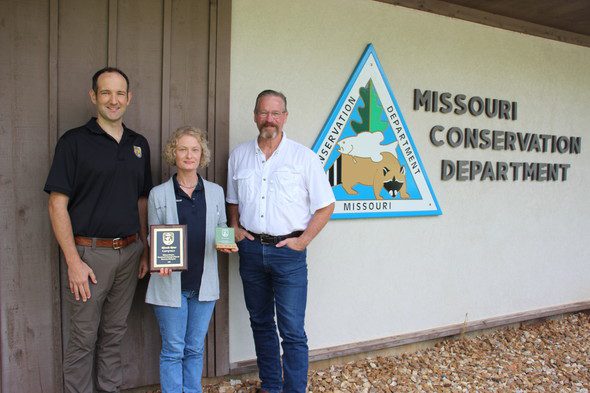

SPRINGFIELD, Mo. – “Threatened species” is a term often associated with ecological gloom. If an animal or plant wears the title of endangered or threatened, it usually means its numbers or habitat – or both – are dwindling.
However, research and field work by Missouri Department of Conservation (MDC) Natural History Biologist Rhonda Rimer has revealed that one of Missouri’s plants – Virginia sneezeweed – has a more promising outlook in the Show-Me State than its federally “threatened” and state “endangered” classifications might imply. Rimer’s work with Virginia sneezeweed has resulted in national recognition for her and optimism for a plant that has an interesting history of discovery and propagation in Missouri.
In May, Rimer received the U.S. Fish and Wildlife Service (USFWS) Midwest Region Threatened and Endangered Species Recovery Award in recognition for her work with Virginia sneezeweed in Missouri. The award was presented to Rimer by USFWS Missouri Deputy Field Supervisor John Weber at MDC’s Southwest Regional Office in Springfield during a regional supervisors’ meeting in August. Rimer’s work with Virginia sneezeweed over the past two decades has been extensive, involving site identification, seed collection, and propagation. She was also a major contributor to the USFWS’ status review of Virginia sneezeweed, which has led to a recommendation to propose the species for removal from the endangered species list due to its recovery.
“Rhonda’s tireless enthusiasm and dedication to the discovery, propagation, and restoration of Virginia sneezeweed represent the highest values of conservation,” said Weber. “The U.S. Fish and Wildlife Service is thrilled to present Rhonda with this incredibly well-deserved recognition and looks forward to seeing what Rhonda and our premier conservation partners at MDC can accomplish next.”
Virginia sneezeweed (Helenium virginicum), a perennial in the aster family, has wedge-shaped yellow flower petals and a ball-shaped center. A number of plants in the Helenium genus have the name “sneezeweed” because the dried leaves of some species were once crushed and used to make snuff. The three species of sneezeweed most common in Missouri are common sneezeweed, purple-headed sneezeweed, and bitterweed.
It was once thought the world-wide range of Virginia sneezeweed consisted of less than 30 sites in its namesake state of Virginia. Missouri’s connection with this plant started, ironically, with a misidentification by famed botanist Julian Steyermark in rural Howell County in 1957. Steyermark, who wrote what is still considered to be the principal reference guide for Missouri plant life, found what he termed “a most puzzling specimen of Helenium” and theorized the plants he saw growing on a south-central Missouri pond bank were hybrids of common and purple-headed sneezeweed.
Further examination, seed collection, and study by Washington and Lee University Professor John Knox in ensuing decades showed the Missouri plant wasn’t a hybrid. Knox, who specializes in Virginia sneezeweed research, confirmed in 2001 that the Missouri plant was, in fact, Virginia sneezeweed. A plant that was thought to be limited to a few sites in Augusta County, Virginia suddenly had a curious and seemingly quite disjointed addition to its range – one site in Howell County, Missouri.
Rimer was named the species recovery leader for this new addition to Missouri’s plant list. In the early 2000s, she, along with staff from the Missouri Botanical Garden, USFWS, and the Center for Plant Conservation, collected Virginia sneezeweed seeds from the site of Steyermark’s original find and began a propagation project that involved growing the seeds in a greenhouse and transplanting them at two sites on public land.
The transplanted plants flourished at these sites, giving Rimer the idea that this plant might not be as rare in Missouri as it was thought to be. Surveys in succeeding years by Rimer on public and private land proved her hunch correct; Virginia sneezeweed has been found at more than 60 sites in Missouri.
A third state, Indiana, was recently added to Virginia sneezeweed’s range thanks to plants being found in a wetland restoration planting. It’s still unclear why this plant has such a seemingly disconnected range. One theory is that perhaps thousands of years ago, Ice Age glaciers split what had been a broader population of Virginia sneezeweed into fragments. Or, perhaps, as glaciers retreated, ensuing warming events dried out wetlands and divided the plant’s population into widely separated parts.
Regardless of what happened with Virginia sneezeweed in the past, it’s the plant’s current presence that Rimer is optimistic about. At a time when headlines are filled with stories of species of animals and plants that are dwindling in numbers, it’s encouraging to hear about a plant that’s doing better than was expected.
“Missourians are stewards of incredible landscapes and biodiversity,” Rimer said. “Virginia sneezeweed demonstrates that there is still so much for us to discover about the plant and animal species in our state.”

















